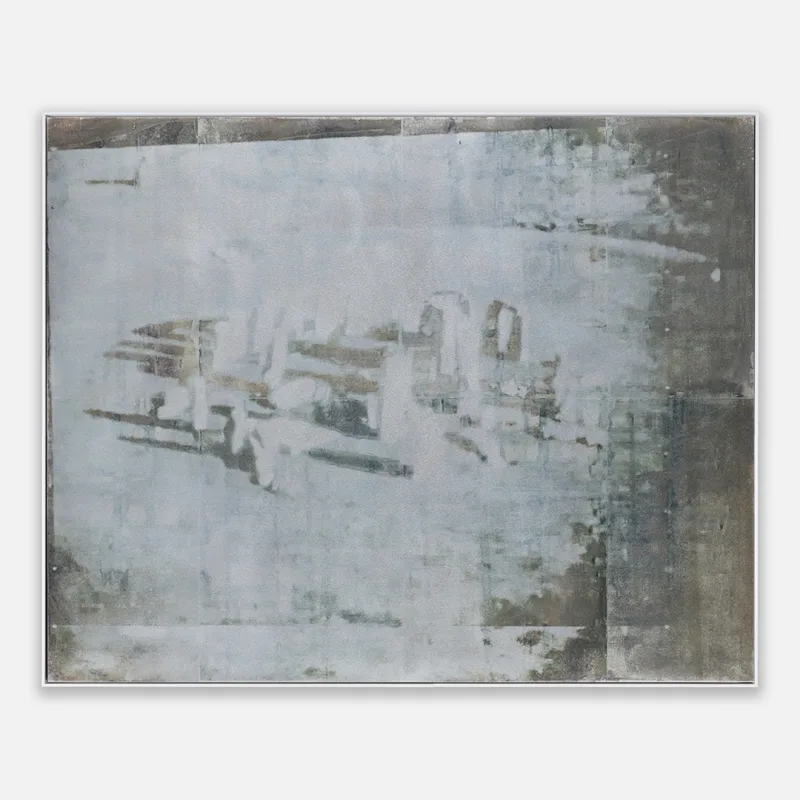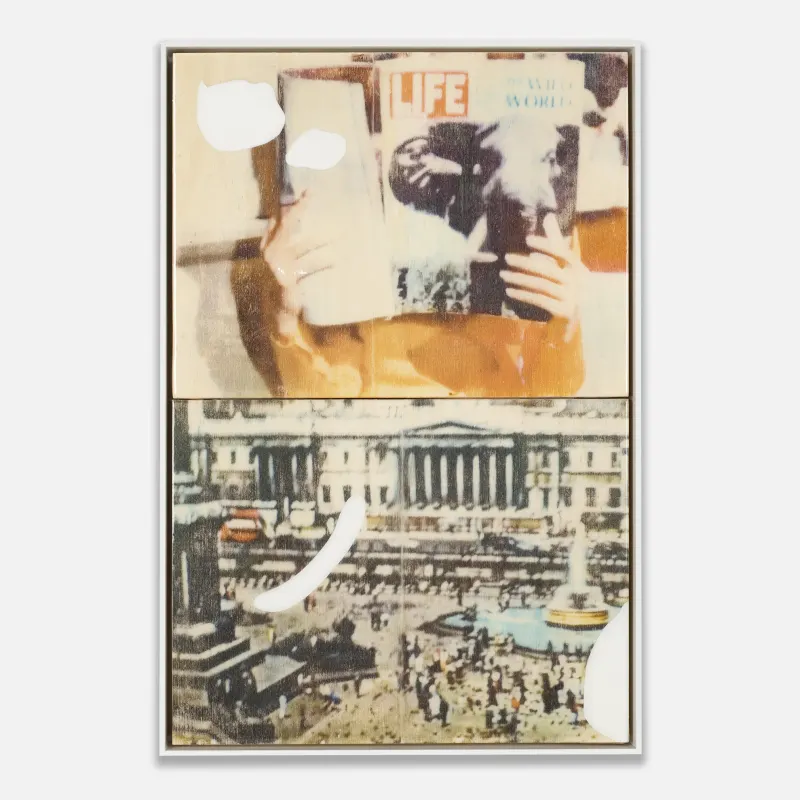The work of Spanish artist Ernesto Cánovas seduces you into the mists of memory, where curiosity, intrigue, and contemplation reign supreme as he explores the fleeting nature of images—those that emerge and those that disappear within the confines of his chosen canvas.
The intrigue of storytelling through art was sparked when Cánovas visited “The Triumph of Painting” in 2005 at Saatchi Gallery, realising that there was much more to painting. Informed by a confluence of cultural forces such as history, cinema, and popular culture, Cánovas depicts this synergy in rich sensory works through a practice of multi-layering painting, drawing, printmaking, and photography. These eclectic cultural references subtly modulate throughout his works.

Image courtesy of the artist and Halcyon Gallery
I’ve always been attracted to the visual arts, but the turning point to pursue a career as an artist was after I went to see “The Triumph of Painting“ in 2005
Ernesto Cánovas
Cánovas’ execution is nothing short of meticulous, as each piece goes through a rigorous process of sanding, drawing, painting, and varnishing, adding depth to his work and reminding us of the medium. Beginning with an image, whether found or appropriated and then imbuing it onto aluminium or wood, the results are explicitly abstract, conceiving slightly ambiguous yet familiar compositions. This brilliance is evident in Cánovas’ rendition of Stonehenge, a piece I particularly admire for its impressionistic portrayal of the mysterious monument shrouded in the ghostly fog of his layered aesthetic.
The allure of Cánovas’ work lies in his deliberate disruption of imagery, each piece shaped and reshaped as if weathered by time itself, blurring the lines between recollection and reinvention. Is each piece a memory preserved or a reality reimagined? It invites us to question—a recollection, a reinvention, or is it something else? This interplay challenges our perceptions, as Cánovas urges us to witness the fleeting nature of images—those that emerge and those that disappear, guided by a tactile yet intimate connection between him and his works.
The Way to the Top, at Halcyon Gallery’s latest exhibition, Songs of the Open Road, which brings together fragments of an otherworldly landscape, playing on the nostalgic imagery of a quintessential American road trip. Exploring the relationship between photography, history, and collective memory, Cánovas works with a range of vintage sources, digitally manipulating images and transferring them onto wooden panels. The hazy, reworked quality of the images appears as a blurry memory or an ethereal dreamscape.
Hi Ernesto, thank you for speaking with us. Could you introduce yourself to those who might not be familiar with your work?
Ernesto Cánovas: I’m an artist based in London, multi-disciplinary but better known for my paintings created from photography as a starting point.
Can you share some early moments from your journey into the arts and explain what motivated you to pursue a career as an artist?
Ernesto Cánovas: I’ve always been attracted to the visual arts, but the turning point to pursue a career as an artist was after I went to see “the Triumph of Painting“ in 2005, it made me realise that there was much more to painting than the classical or 20th-century stuff….you could be a storyteller in your own way and that was it.

Mixed media on aluminum
100 x 140 cm
Image courtesy of the artist and Halcyon Gallery
Your practice raises intriguing questions about societal issues, including social infrastructure and global economic chaos, underpinned by historical and cinematic inspiration. Using a multi-layered technique with found imagery, digital manipulation, and mixed media, can we delve into your practice, inspiration, and the themes within your work?
Ernesto Cánovas: When I was a student at university I had this amazing tutor, she was an artist…but she was also a philosopher in her own way. She used to say that artists spend time in the studio to earn some skills but we also have an obligation to observe, looking around and paying attention.. to the small things, and the big things. Basically, everything can inspire you in some way or another if you pay attention so that is what I’m trying to do.
My work explores the concept of appearing and disappearing images; each piece has multiple stages – starting with a photograph, found or appropriated, which is transposed onto aluminium or wood panels. I love the effect the grain of the wood has on the original image. I then begin the process of sanding, drawing, painting, varnishing to give a sense of depth. I often incorporate flecks of flat colour or 3-dimensional ceramics over the top of the painting to add a sense of energy. But it also disrupts the flow of the composition – reminding the viewer of the medium.
How has your background and cultural heritage influenced your artistic style and subject matter?
Ernesto Cánovas: I have done a lot of traveling and even if my heritage is mediterranean, I am influenced by all sorts of things… my works are sensory, so different cultural influences might affect the sense of the piece, the light, the composition, or expression.
One of my earlier collections was called ‘An American Trilogy’ created in 2014 and of course this is my representation of Americana and its influence on the rest of the world. Many of these works have a cinematic quality, reminiscent of old Hollywood films – it reflects a romanticised ‘Americanness’.

Mixed media and resin on wood
60 x 40 cm
Image courtesy of the artist and Halcyon Gallery
How do you select the images you work with? Is there a specific criterion or thematic focus that guides your choices?
Ernesto Cánovas: No, as I mentioned before, you can get inspired by anything and I’m an artist that uses intuition most of the time – I just start working and see where it takes me. I have a vast collection of old photos, magazine clippings and postcards in the studio – some taken by me, some vintage – mostly found.
Layering is a significant aspect of your technique. How do you decide the number of layers, and what factors influence your choice of materials such as acrylic, ink, and varnish?
Ernesto Cánovas: Every image has different demands and the process and order of applying techniques changes constantly- there isn’t a formula or a script to follow. In starting with an old photo, it’s like you are being invited into a personal memory – it’s a feeling, a sense of things – which develops as I work.

Mixed media and resin on wood
138 x 61 cm
Image courtesy of the artist and Halcyon Gallery
Can we discuss the role of colour in your work, particularly the use of bright, abstract flashes that disrupt vintage iconography?
Ernesto Cánovas: A lot of the time the images I use have this nostalgic tone and nostalgia can evoke sadness. One way to avoid that is to balance it with colour and it also makes the whole thing more dynamic. The flashes add energy, and a bit of hope.
You’ve mentioned that the image becomes a “second-generation image” once transferred to the wooden panel. Can you expand on the philosophical significance of this transformation and how it relates to your overall artistic vision?
Ernesto Cánovas: To begin, I use a found image (or one of my own), but I like to manipulate them – this way, they become a ‘second-generation’ image, they get an upgrade… and from there, it becomes something else.

Image courtesy of the artist and Halcyon Gallery
Looking ahead, how do you see your practice evolving? Are there new themes or techniques you are interested in exploring?
Ernesto Cánovas: There is always room for learning new techniques and exploring new themes…. lately I have been thinking of nature and aesthetic control and somehow Ikebana composition – the Japanese art of arranging flowers to convey a feeling or emotion – is now a preoccupation, so future paintings may use this as a starting point.
Lastly, could you share your philosophy of art? How do you describe and understand the core importance of art in your life and career?
Ernesto Cánovas: When people ask me what I do for living…I find hard to said that I ‘work’ as an artist because I don’t consider it a job, for me its a way of life, a way of being. I wouldn’t do anything else – this is just how I am.
©2024 Ernesto Cánovas




